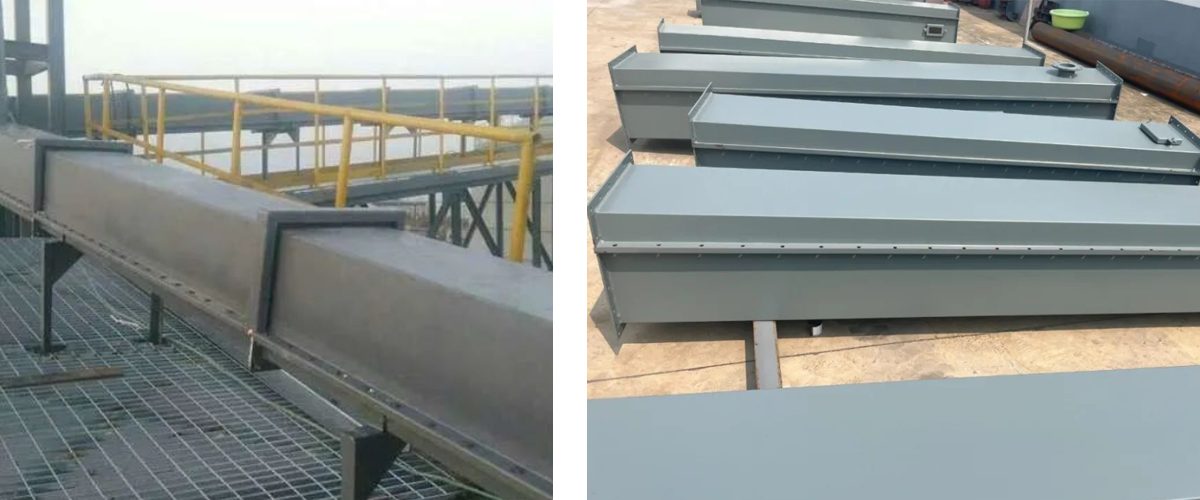In modern cement production, the smooth operation of air slide conveyor is very important. Recently, a cement plant has been blocked for many times during the trial operation, which has seriously affected the normal production. This paper discusses the causes of blockage and the corresponding solutions.
What is an air slide conveyor?
The air slide conveyor is a bulk material handling system, which uses a layer of air to convey dry powder materials along the inclined channel. It has a porous surface, allowing air circulation, forming a fluidized bed, so that the material moves smoothly and gently. The system is energy-saving and efficient, and is often used in cement and food processing industries.
How Air Slide Conveyors Work
The air slide conveyor uses the air layer along the inclined channel to convey dry powdery materials. Its porous surface allows air circulation to form a fluidized bed. This design reduces friction, so that the material can move smoothly without mechanical parts. Therefore, the air chute conveyor operates efficiently and is often used in industries such as cement and food processing to ensure the gentle handling of bulk materials.
Material Impact
The moisture content of raw materials is an important factor causing blockage. For example, the moisture content of clay can reach 8% to 10%. The cement plant uses a single chamber air swept drying mill. When the air flow is strong, the moisture content of the milled material may exceed 1%. High temperature and viscous materials will block the pores of the air passage layer, resulting in uneven air flow and blocking of the air flow conveyor. In addition, during shutdown, the residual materials in the conveyor will be cooled and condensed, aggravating the blockage. In order to solve these problems, the factory has taken the following measures:
- Strictly Control Material Moisture: The moisture content of incoming clay is kept below 6%. The gas temperature from the mill is controlled between 90 and 100°C, ensuring the moisture content of the milled material does not exceed 0.8%.
- Emergency Cleaning Measures: In the event of unexpected long shutdowns, operators must open the conveyor cover and manually clear the material.
Mill Impact
During the initial trial of the cement mill, the spacing of the discharge grate was too wide, and issues with the rotary screen allowed iron scraps, small steel balls, and coarse materials to mix into the milled cement. These materials entered the air slide conveyor via the bucket elevator and accumulated in the aeration layer. When enough material builds up, the injected air cannot fluidize it properly, leading to blockages. To combat this, the workshop took the following actions:
- Adjust the Mill Discharge Grate Spacing: This ensures smooth discharge and prevents coarse materials and impurities from entering the conveyor.
- Set Up Monitoring Points: Monitoring devices were installed at the bucket elevator outlet and the conveyor entrance. Regular checks help clear any accumulated iron scraps and coarse materials.
Conveyor Impact
(1) Sealing Issues
The lower conveyor body was not sealed properly, causing air leaks. This reduced the pressure difference across the aeration layer, preventing proper fluidization of materials and making transport difficult. Upon discovery, the following actions were taken:
- Enhance Sealing: Additional clamps or sealing tape were used to address air leakage.
(2) Aeration Layer Damage
Damage to the aeration layer can cause air to short-circuit, leading to air jets that obstruct the material flow. As a result, blockages occur. To resolve this, the plant took immediate action:
- Regularly Inspect the Aeration Layer: Any damage should be addressed promptly with repairs or replacements.
(3) Exhaust Design Problems
The upper conveyor shall maintain zero pressure or slight negative pressure. However, the design of the plant connects the exhaust port of the conveyor to the bucket elevator housing, which is not connected to the dust removal system. This leads to insufficient exhaust and positive pressure of the upper conveyor, and the material is difficult to fluidize. To solve this problem, the factory implemented the following solutions:
- Redesign Exhaust Outlets: The conveyor’s exhaust was connected to relevant equipment to ensure smooth airflow.
- Control Air Inflow: The opening of air valves was adjusted based on material characteristics to ensure even airflow and reduce blockage risks.
(4) Weather Impact
The plant’s outdoor air slide conveyor of the plant is exposed to rainwater, which seeps through the gap, causing the material to become viscous and finally causing blockage. In order to solve this problem, the factory has taken the following measures:
- Install Rain Protection: The outdoor conveyors were modified with protective measures to prevent rain from entering and affecting material properties.

In conclusion, through thorough analysis and effective solutions for air slide conveyor blockages, the cement plant has improved its operating procedures and established preventive measures. After over a year and a half of production, the operation of the air slide conveyors has stabilized, ensuring smooth cement production.
For more information or technical support, please feel free to contact us. We look forward to collaborating with you to enhance the efficiency and safety of cement production.

